Integrating Evacuation and Storm Surge Modeling Considering Potential Hurricane Tracks: The Case of Hurricane Irma in Southeast Florida
Abstract
:1. Introduction
2. Methods
2.1. Study Area and Hurricane Irma
2.2. Data Description
2.3. Methodology under Hurricane Irma-Hypothetical Track Hitting Miami
2.3.1. Storm Surge Modeling
2.3.2. Integrating Storm Surge and Evacuation Modeling
2.3.3. Scenario Assumptions
- 12-h S-curve loading was used.
- Evacuation level D (based on a category 4 hurricane) was considered.
- Inland areas (areas other than the designated evacuation zones) usually experience a shadow evacuation, which was accounted for in the proposed methodology. Evacuations emanating from areas under mandatory evacuation orders were modeled in accordance with the planning assumptions developed by the Statewide Regional Evacuation Study Program (SRESP).
- Background traffic was implemented as link capacity fluctuations due to the computational power limitations of the TIME software.
- Highway network was modified based on the roadways that have a higher risk of inundation to model a post-disaster network.
- All public shelters were considered.
- Dynamic travel times were obtained for the time segment where evacuation volume was the highest overall in the network.
- We assumed a passenger per vehicle rate of 1.8 during the evacuation in the TIME software.
| Demographic Data | 2020 |
|---|---|
| Highway Network | 2020 |
| One-Way Operations | None |
| University Population | Include |
| Tourist Rate | Include |
| Shelters | All open |
| Response Curve | 12-h S-curve Loading |
| Behavioral Response | 100% Response |
| Evacuation Level | Level D (Category 4) |
| Regional Destination Rates | South Florida RPC |
| Counties Evacuating | Broward, Miami-Dade, and Palm Beach |
3. Results and Discussions
4. Conclusions, Limitations, and Future Work
Author Contributions
Funding
Institutional Review Board Statement
Informed Consent Statement
Data Availability Statement
Acknowledgments
Conflicts of Interest
References
- Ghorbanzadeh, M.; Koloushani, M.; Ulak, M.B.; Ozguven, E.E.; Arghandeh, R. Statistical and spatial analysis of Hurricane-induced roadway closures and power outages. Energies 2020, 13, 1098. [Google Scholar] [CrossRef] [Green Version]
- Zou, Q.; Chen, S. Resilience Modeling of Interdependent Traffic-Electric Power System Subject to Hurricanes. J. Infrastruct. Syst. 2020, 26, 04019034. [Google Scholar] [CrossRef]
- National Oceanic and Atmospheric Administration. Hurricane Costs. Available online: https://coast.noaa.gov/states/fast-facts/hurricane-costs.html (accessed on 20 March 2021).
- Ghorbanzadeh, M.; Koloushani, M.; Ozguven, E.E.; Vanli, A.; Arghandeh, R. City transportation network vulnerability to disasters: The case of Hurricane Hermine in Florida. Environ. Hazards 2021, 1–19. [Google Scholar] [CrossRef]
- National Oceanic and Atmospheric Administration. Economics and Demographics. Available online: https://coast.noaa.gov/states/fast-facts/economics-and-demographics.html (accessed on 20 July 2021).
- Dow, K.; Cutter, S.L. Emerging hurricane evacuation issues: Hurricane Floyd and South Carolina. Hazards Vulnerabil. Environ. Justice 2012, 385–397. [Google Scholar] [CrossRef]
- Tanaka, K.; Nagatani, T.; Hanaura, H. Traffic congestion and dispersion in Hurricane evacuation. Phys. A Stat. Mech. Its Appl. 2007, 376, 617–627. [Google Scholar] [CrossRef]
- Hurricane Central Irma Prompts Mandatory Evacuation Order in Florida Keys: “The Sooner People Leave, the Better”. Available online: https://weather.com/storms/hurricane/news/hurricane-irma-florida-puerto-rico-caribbean (accessed on 20 July 2021).
- Stein, P.; Berman, M.; Lowery, W. Hurricane Irma Makes Second Landfall in Florida and Will Roar up the State’s Gulf Coast. The Washington Post. 10 September 2017. Available online: https://www.washingtonpost.com/news/post-nation/wp/2017/09/10/hurricane-irma-makes-landfall-in-florida-keys-targets-gulf-coast/ (accessed on 10 July 2021).
- Zhu, Y.J.; Hu, Y.; Collins, J.M. Estimating road network accessibility during a hurricane evacuation: A case study of hurricane Irma in Florida. Transp. Res. Part D Transp. Environ. 2020, 83, 102334. [Google Scholar] [CrossRef]
- Yang, H.; Morgul, E.F.; Ozbay, K.; Xie, K. Modeling evacuation behavior under hurricane conditions. Transp. Res. Rec. 2016, 2599, 63–69. [Google Scholar] [CrossRef] [Green Version]
- Wilmot, C.G.; Meduri, N. Methodology to establish hurricane evacuation zones. Transp. Res. Rec. 2005, 1922, 129–137. [Google Scholar] [CrossRef]
- Senkbeil, J.; Reed, J.; Collins, J.; Brothers, K.; Saunders, M.; Skeeter, W.; Cerrito, E.; Chakraborty, S.; Polen, A. Perceptions of hurricane-track forecasts in the united states. Weather. Clim. Soc. 2020, 12, 15–29. [Google Scholar] [CrossRef]
- FEMA. Mitigation Assessment Report of Hurricane Irma in Florida; FEMA: Miami, FL, USA, 2018. [Google Scholar]
- Dietrich, J.C.; Tanaka, S.; Westerink, J.J.; Dawson, C.N.; Luettich, R.A.; Zijlema, M.; Holthuijsen, L.H.; Smith, J.M.; Westerink, L.G.; Westerink, H.J. Performance of the unstructured-mesh, SWAN+ ADCIRC model in computing hurricane waves and surge. J. Sci. Comput. 2012, 52, 468–497. [Google Scholar] [CrossRef]
- Sebastian, A.; Proft, J.; Dietrich, J.C.; Du, W.; Bedient, P.B.; Dawson, C.N. Characterizing hurricane storm surge behavior in Galveston Bay using the SWAN+ADCIRC model. Coast. Eng. 2014, 88, 171–181. [Google Scholar] [CrossRef]
- Siverd, C.G.; Hagen, S.C.; Bilskie, M.V.; Braud, D.W.H.; Gao, S.; Peele, R.H.; Twilley, R.R. Assessment of the temporal evolution of storm surge across coastal Louisiana. Coast. Eng. 2019, 150, 59–78. [Google Scholar] [CrossRef]
- Rucker, C.A.; Tull, N.; Dietrich, J.C.; Langan, T.E.; Mitasova, H.; Blanton, B.O.; Fleming, J.G.; Luettich, R.A. Downscaling of real-time coastal flooding predictions for decision support. Nat. Hazards 2021, 107, 1341–1369. [Google Scholar] [CrossRef]
- Wang, Y.; Mao, X.; Jiang, W. Long-term hazard analysis of destructive storm surges using the ADCIRC- SWAN model: A case study of Bohai Sea, China. Int. J. Appl. Earth Obs. Geoinf. 2018, 73, 52–62. [Google Scholar] [CrossRef]
- Reffitt, M.; Orescanin, M.M.; Massey, C.; Raubenheimer, B.; Jensen, R.E.; Elgar, S. Modeling Storm Surge in a Small Tidal Two-Inlet System. J. Waterw. Port Coast. Ocean Eng. 2020, 146, 04020043. [Google Scholar] [CrossRef]
- Liu, Z.; Wang, H.; Zhang, Y.J.; Magnusson, L.; Loftis, J.D.; Forrest, D. Cross-scale modeling of storm surge, tide, and inundation in Mid-Atlantic Bight and New York City during Hurricane Sandy, 2012. Estuar. Coast. Shelf Sci. 2020, 233, 106544. [Google Scholar] [CrossRef]
- Murray-Tuite, P.; Wolshon, B. Evacuation transportation modeling: An overview of research, development, and practice. Transp. Res. Part C Emerg. Technol. 2013, 27, 25–45. [Google Scholar] [CrossRef]
- Edara, P.; Sharma, S.; McGhee, C. Development of a large-scale traffic simulation model for hurricane evacuation-methodology and lessons learned. Nat. Hazards Rev. 2010, 11, 127–139. [Google Scholar] [CrossRef]
- Wolshon, B.; McArdle, B. Traffic impacts and dispersal patterns on secondary roadways during regional evacuations. Nat. Hazards Rev. 2011, 12, 19–27. [Google Scholar] [CrossRef]
- Sadri, A.M.; Ukkusuri, S.V.; Murray-Tuite, P.; Gladwin, H. How to evacuate: Model for understanding the routing strategies during hurricane evacuation. J. Transp. Eng. 2013, 140, 61–69. [Google Scholar] [CrossRef]
- Major, W.; Can, D.; Transportation, T. Lessons From Katrina and Rita. J. Transp. Eng. 2006, 132, 11–18. [Google Scholar]
- Wolshon, B. “One-way-out”: Contraflow freeway operation for hurricane evacuation. Nat. Hazards Rev. 2001, 2, 105–112. [Google Scholar] [CrossRef]
- Martín, Y.; Li, Z.; Cutter, S.L. Leveraging Twitter to gauge evacuation compliance: Spatiotemporal analysis of Hurricane Matthew. PLoS ONE 2017, 12, e0181701. [Google Scholar] [CrossRef] [Green Version]
- Squicciarini, A.; Tapia, A.; Stehle, S. Sentiment analysis during Hurricane Sandy in emergency response. Int. J. Disaster Risk Reduct. 2017, 21, 213–222. [Google Scholar] [CrossRef] [Green Version]
- Yin, W.; Murray-Tuite, P.; Ukkusuri, S.V.; Gladwin, H. An agent-based modeling system for travel demand simulation for hurricane evacuation. Transp. Res. Part C Emerg. Technol. 2014, 42, 44–59. [Google Scholar] [CrossRef]
- Zhang, Z.; Wolshon, B.; Murray-Tuite, P. A conceptual framework for illustrating and assessing risk, resilience, and investment in evacuation transportation systems. Transp. Res. Part D Transp. Environ. 2019, 77, 525–534. [Google Scholar] [CrossRef]
- Lindell, M.K.; Murray-Tuite, P.; Wolshon, B.; Baker, E.J. Large-Scale Evacuation; CRC Press: New York, NY, USA, 2018. [Google Scholar]
- Lindell, M.K.; Murray-Tuite, P.; Wolshon, B.; Baker, E.J. Large-Scale Evacuation: The Analysis, Modeling, and Management of Emergency Relocation from Harzardous Areas; CRC Press: New York, NY, USA, 2019. [Google Scholar]
- Huang, S.K.; Lindell, M.K.; Prater, C.S. Who Leaves and Who Stays? A Review and Statistical Meta-Analysis of Hurricane Evacuation Studies. Environ. Behav. 2016, 48, 991–1029. [Google Scholar] [CrossRef]
- Thompson, R.R.; Garfin, D.R.; Silver, R.C. Evacuation from Natural Disasters: A Systematic Review of the Literature. Risk Anal. 2017, 37, 812–839. [Google Scholar] [CrossRef] [Green Version]
- Wolshon, B.; McArdle, B. Temporospatial Analysis of Hurricane Katrina Regional Evacuation Traffic Patterns. J. Infrastruct. Syst. 2009, 15, 12–20. [Google Scholar] [CrossRef]
- Wolshon, B.; Urbina Hamilton, E.; Levitan, M.; Wilmot, C. Review of Policies and Practices for Hurricane Evacuation. II: Traffic Operations, Management, and Control. Nat. Hazards Rev. 2005, 6, 143–161. [Google Scholar] [CrossRef]
- Yabe, T.; Ukkusuri, S.V. Effects of income inequality on evacuation, reentry and segregation after disasters. Transp. Res. Part D Transp. Environ. 2020, 82, 102260. [Google Scholar] [CrossRef]
- Zhu, Y.; Xie, K.; Ozbay, K.; Yang, H. Hurricane Evacuation Modeling Using Behavior Models and Scenario-Driven Agent-based Simulations. Procedia Comput. Sci. 2018, 130, 836–843. [Google Scholar] [CrossRef]
- Vitetta, A.; Musolino, G.; Marcianò, F.A. Safety of users in road evacuation: Modelling and DSS for transport supply and supply-demand interaction. WIT Trans. Ecol. Environ. 2009, 120, 475–484. [Google Scholar] [CrossRef] [Green Version]
- Vitetta, A.; Musolino, G.; Marcian, F.A. Safety of users in road evacuation: Supply and demand-supply interaction models for users. WIT Trans. Built Environ. 2007, 96, 783–792. [Google Scholar] [CrossRef] [Green Version]
- Marcianò, F.A.; Musolino, G.; Vitetta, A. A system of models for signal setting design of a signalized road network in evacuation conditions. WIT Trans. Built Environ. 2010, 111, 313–323. [Google Scholar] [CrossRef] [Green Version]
- Di Gangi, M.; Musolino, G.; Russo, F.; Velonà, P.; Vitetta, A. Analysis and comparison of several urban road transportation assignment models in emergency conditions. Sustain. World 2003, 8, 247–257. [Google Scholar] [CrossRef] [Green Version]
- Marcianò, F.A.; Musolino, G.; Vitetta, A. Signal setting optimization on urban road transport networks: The case of emergency evacuation. Saf. Sci. 2015, 72, 209–220. [Google Scholar] [CrossRef]
- Russo, F.; Rindone, C. Data Envelopment Analysis (DEA) for evacuation planning. WIT Trans. Inf. Commun. Technol. 2010, 43, 455–467. [Google Scholar] [CrossRef] [Green Version]
- Wong, S.D.; Pel, A.J.; Shaheen, S.A.; Chorus, C.G. Fleeing from hurricane Irma: Empirical analysis of evacuation behavior using discrete choice theory. Transp. Res. Part D Transp. Environ. 2020, 79, 102227. [Google Scholar] [CrossRef] [Green Version]
- Roy, K.C.; Hasan, S. Modeling the dynamics of hurricane evacuation decisions from twitter data: An input output hidden markov modeling approach. Transp. Res. Part C Emerg. Technol. 2021, 123, 102976. [Google Scholar] [CrossRef]
- Sadri, A.M.; Ukkusuri, S.V.; Murray-Tuite, P.; Gladwin, H. Hurricane evacuation route choice of major bridges in Miami Beach, Florida. Transp. Res. Rec. 2015, 2532, 164–173. [Google Scholar] [CrossRef]
- Kocatepe, A. Evacuating and Sheltering Aging Populations: A GIS- and Optimization-Based Methodology; Florida State University: Tallahassee, FL, USA, 2017; Available online: https://www.proquest.com/openview/688f5c5b0dcfe0fe13f38f9ef6c5e6f4/1?pq-origsite=gscholar&cbl=18750&diss=y. (accessed on 15 September 2021).
- CDM Smith. Building a Robust Hurricane Evacuation Model for Florida. Available online: https://www.cdmsmith.com/en/Client-Solutions/Projects/Florida-Department-of-Emergency-Management-Hurricane-Evacuation-Model?fbclid=IwAR3SIon2j5yxkKJ_8uH8BjjkYeNgJT6Bw0Cq1BGh-sZWA3sLc-UGDcYZuWc (accessed on 15 September 2021).
- Marasco, D.; Murray-Tuite, P.; Guikema, S.; Logan, T. Time to leave: An analysis of travel times during the approach and landfall of Hurricane Irma. Nat. Hazards 2020, 103, 2459–2487. [Google Scholar] [CrossRef]
- Staes, B.; Menon, N.; Bertini, R.L. Analyzing transportation network performance during emergency evacuations: Evidence from Hurricane Irma. Transp. Res. Part D Transp. Environ. 2021, 95, 102841. [Google Scholar] [CrossRef]
- Ghorbanzadeh, M.; Burns, S.; Rugminiamma, L.V.N.; Erman Ozguven, E.; Huang, W. Spatiotemporal Analysis of Highway Traffic Patterns in Hurricane Irma Evacuation. Transp. Res. Rec. J. Transp. Res. Board 2021, 036119812110018. [Google Scholar] [CrossRef]
- Huang, W.; Yin, K.; Ghorbanzadeh, M.; Vijayan, L.; Ozguven, E.E. Integrating storm surge modeling with traffic data analysis to evaluate the effectiveness of hurricane evacuation. Front. Struct. Civ. Eng. 2021. [Google Scholar] [CrossRef]
- National Oceanic and Atmospheric Administration. 2018; Administration. Available online: https://oceanservice.noaa.gov/annualreport/2017/hurricane-irma.html (accessed on 20 January 2018).
- Maul, W. Preparedness, Response and Rebuilding: Lessons from the 2017 Disasters; Florida Division of Emergency Management: Tallahassee, FL, USA, 2018.
- So, S.; Juarez, B.; Valle-Levinson, A.; Gillin, M.E. Storm surge from Hurricane Irma along the Florida Peninsula. Estuar. Coast. Shelf Sci. 2019, 229, 106402. [Google Scholar] [CrossRef]
- Cangialosi, J.; Latto, A.; Berg, R. Hurricane Irma. 2018. Available online: https://www.nhc.noaa.gov/data/tcr/AL112017_Irma.pdf (accessed on 25 September 2021).
- Rahman, R.; Bhowmik, T.; Eluru, N.; Hasan, S. Assessing the crash risks of evacuation: A matched case-control approach applied over data collected during Hurricane Irma. Accid. Anal. Prev. 2021, 159, 106260. [Google Scholar] [CrossRef] [PubMed]
- National Hurricane Center and National Oceanic and Atmospheric Administration. Available online: https://www.nhc.noaa.gov/archive/2017/IRMA_graphics.php?product=5day_cone_with_line_and_wind (accessed on 8 January 2020).
- Florida Division of Emergency Management. Florida Statewide Regional Evacuation Study Program (SRESP); Florida Division of Emergency Management: Tallahassee, FL, USA, 2015.
- Florida Division of Emergency Management. South Florida Regional Planning Council; Florida Division of Emergency Management: Tallahassee, FL, USA, 2015.
- Florida Department of Transportation (FDOT) Florida Statewide Model. Available online: https://www.fsutmsonline.net/index.php?/model_pages/modDS1/index/ (accessed on 10 March 2021).
- Vijayan, L.; Huang, W.; Yin, K.; Ozguven, E.; Burns, S.; Ghorbanzadeh, M. Evaluation of parametric wind models for more accurate modeling of storm surge: A case study of Hurricane Michael. Nat. Hazards 2021, 106, 2003–2024. [Google Scholar] [CrossRef]
- Burns, S. Assessing the Vulnerability of Florida Panhandle Communities Impacted by Hurricane Michael Using Geographic Information Systems; Florida Agricultural and Mechanical University: Tallahassee, FL, USA, 2020; Available online: https://www.proquest.com/openview/985da4256064a4a54a22d07b001eefb2/1?pq-origsite=gscholar&cbl=18750&diss=y. (accessed on 25 September 2021).
- Florida Department of Transportation (FDOT). Florida Standard Urban Transportation Modeling System (FSUTMS). 2020. Available online: https://www.fsutmsonline.net/index.php (accessed on 20 March 2020).
- Zhang, Z.; Herrera, N.; Tuncer, E.; Parr, S.; Shapouri, M.; Wolshon, B. Effects of Shadow Evacuation on Megaregion Evacuations. Transp. Res. Part D Transp. Environ. 2020, 83, 102295. [Google Scholar] [CrossRef]
- Florida Regional Councils Association (FRCA); Florida Regional Councils Association (FRCA). 2019. Available online: http://www.flregionalcouncils.org/ (accessed on 20 July 2021).
- Sin, H.G.; Joo, Y.J. Development of urban disaster evacuation model using Cube Avenue. Spat. Inf. Res. 2017, 25, 513–521. [Google Scholar] [CrossRef]
- Wong, K.F. Transportation Planning: Travel Demand Modeling Forecast Model Conversion from TransCAD to Cube Voyager. In Proceedings of the 7th International Conference of Chinese Transportation Professionals Congress 2007: Plan, Build, and Manage Transportation Infrastructures in China, Shanghai, China, 21–22 May 2007; ASCE: Reston, VA, USA, 2008; pp. 30–42. [Google Scholar] [CrossRef]
- Miquel, R. Florida Statewide Hurricane Evacuation Model—TIME. Available online: https://www.fsutmsonline.net/index.php/model_task_f/mtfdocs/ (accessed on 21 September 2021).
- Hadi, M.; Ozen, H.; Shabanian, S.; Xiao, Y. Use of Dynamic Traffic Assignment in FSUTMS in Support of Transportation Planning in Florida; Florida International University Lehman Center for Transportation: Research: Miami, FL, USA, 2012. [Google Scholar]
- Lindell, M.K.; Sorensen, J.H.; Baker, E.J.; Lehman, W.P. Community response to hurricane threat: Estimates of household evacuation preparation time distributions. Transp. Res. Part D Transp. Environ. 2020, 85, 102457. [Google Scholar] [CrossRef]
- Effects of Hurricane Irma in Florida. 2021. Available online: https://en.wikipedia.org/wiki/Effects_of_Hurricane_Irma_in_Florida (accessed on 10 September 2021).
- Kim, K.; Wolshon, B.; Pant, P.; Yamashita, E.; Ghimire, J. Assessment of evacuation training needs: Targeting instruction to meet the requirements of local communities and agencies. J. Emerg. Manag. 2020, 18, 475–487. [Google Scholar] [CrossRef] [PubMed]


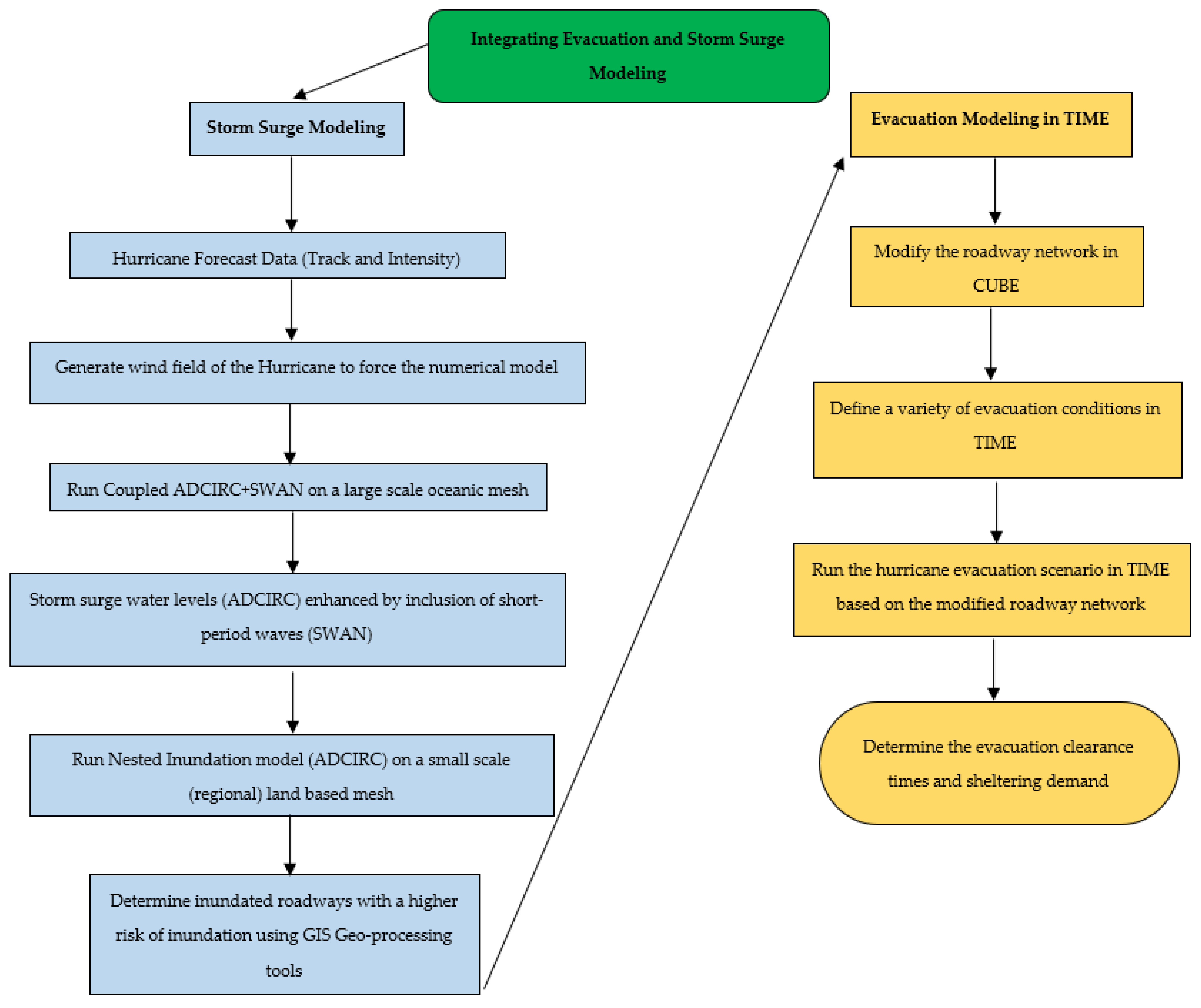
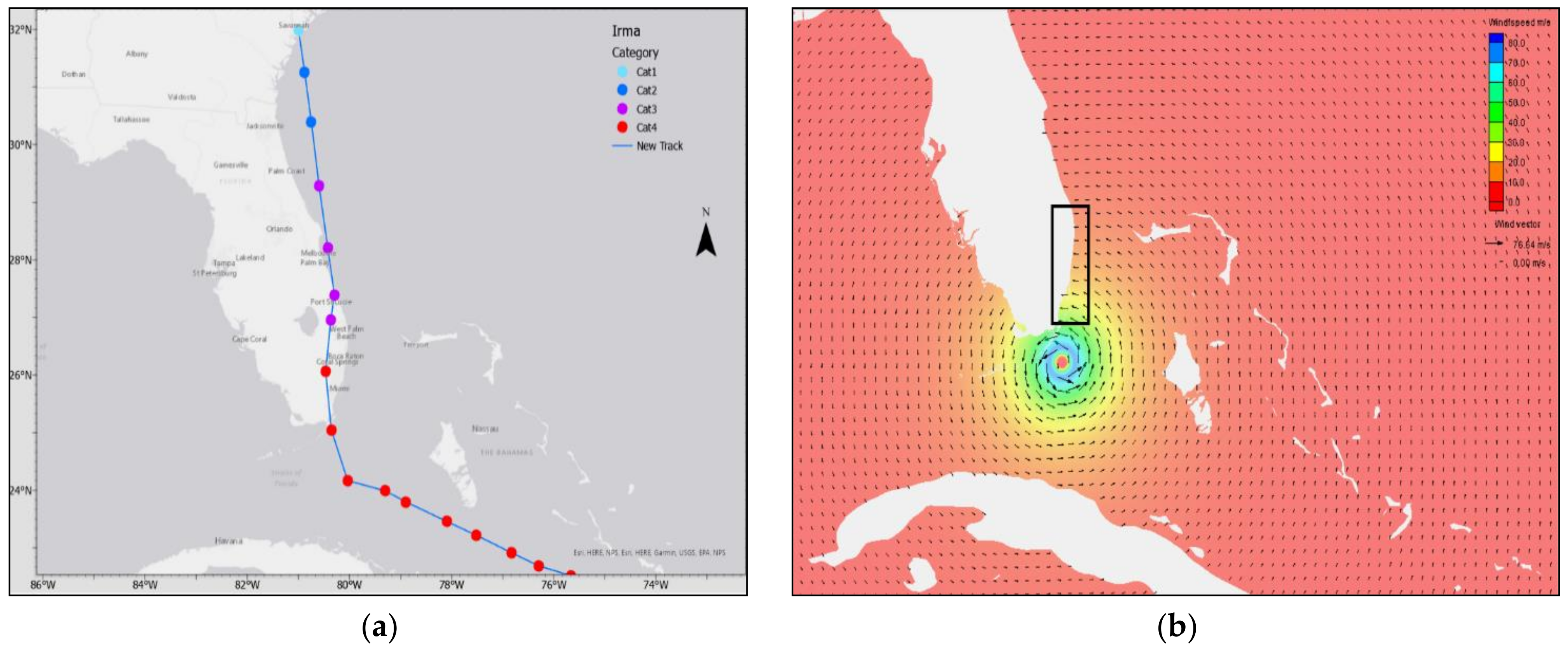
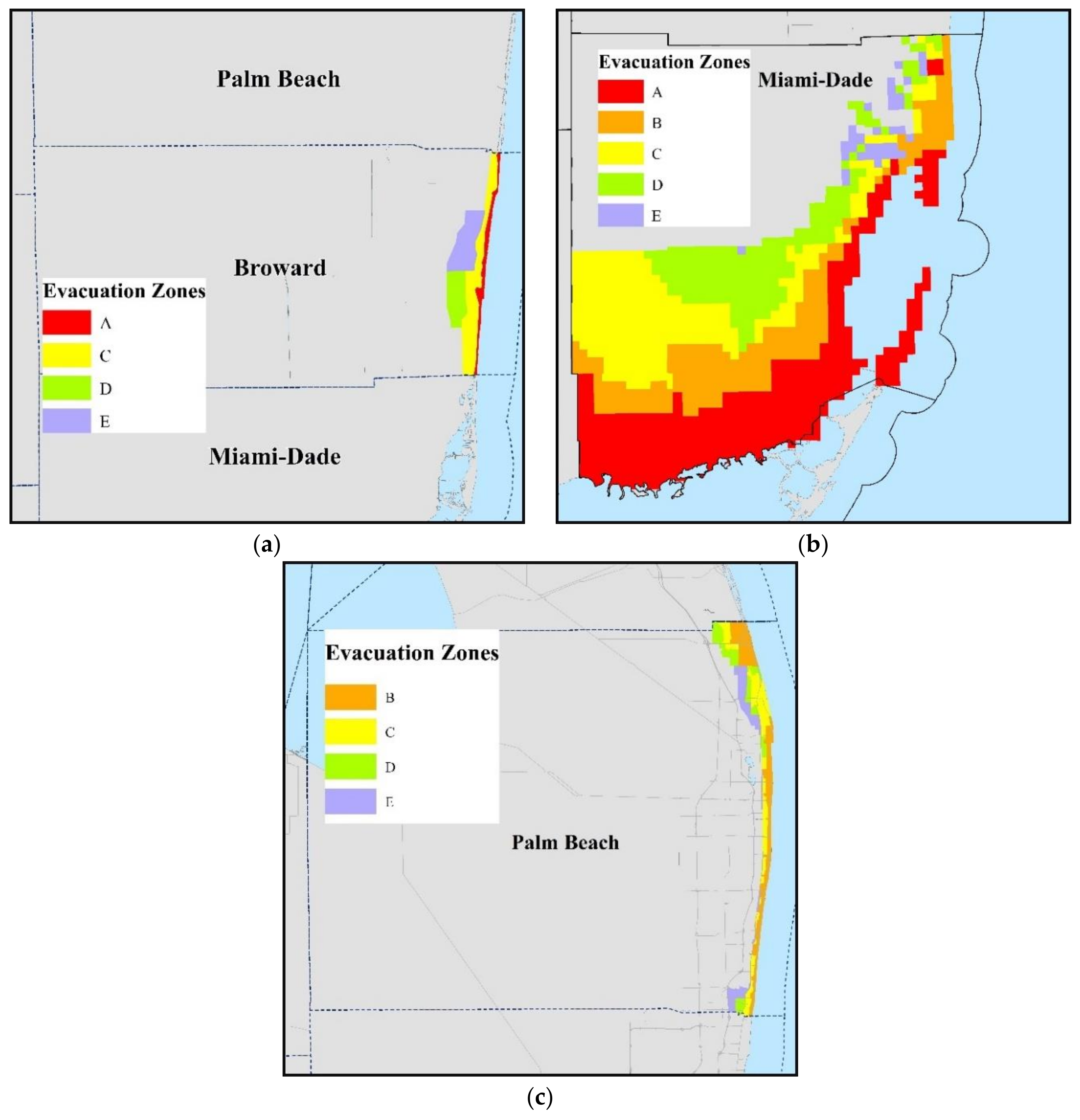
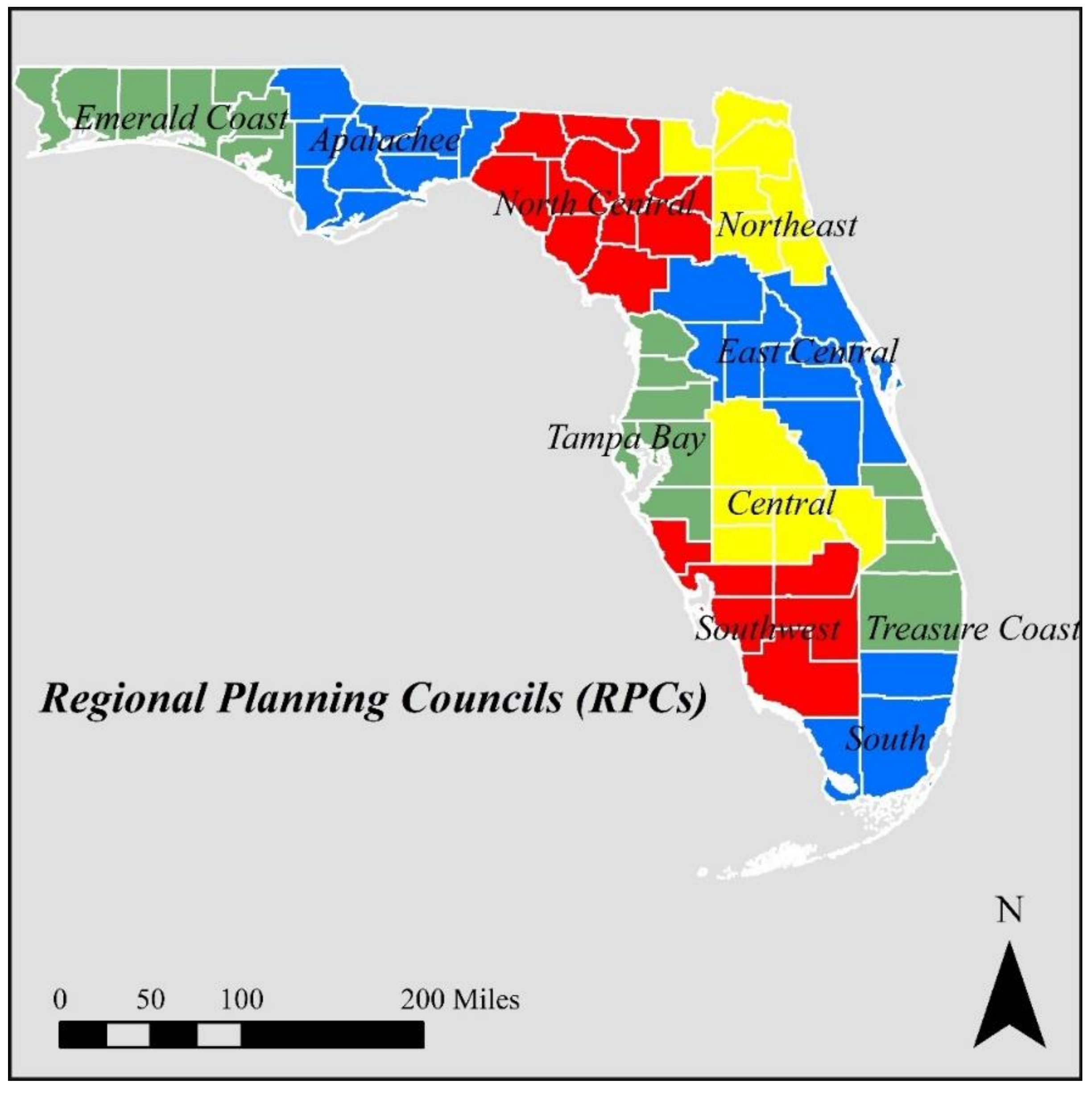
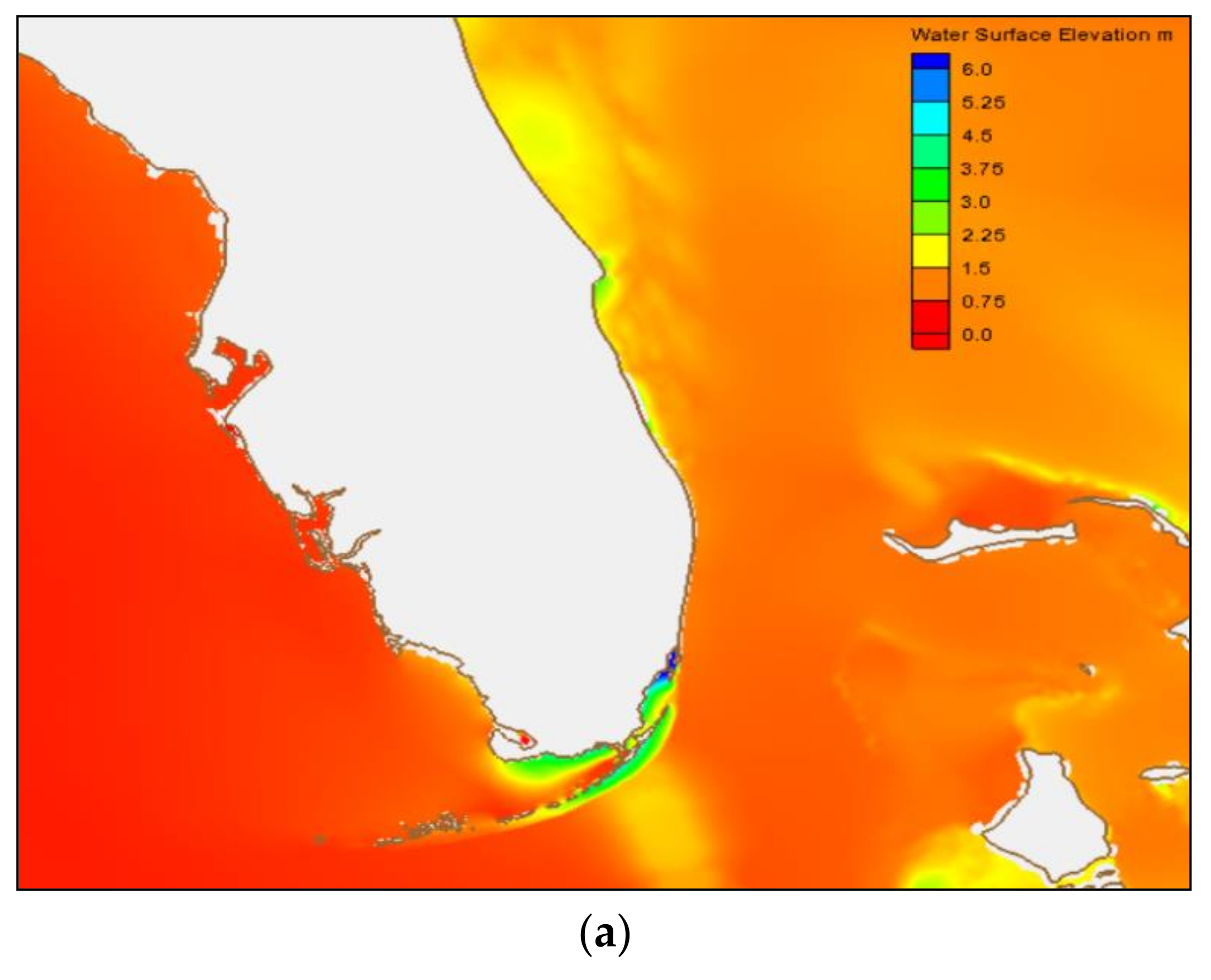
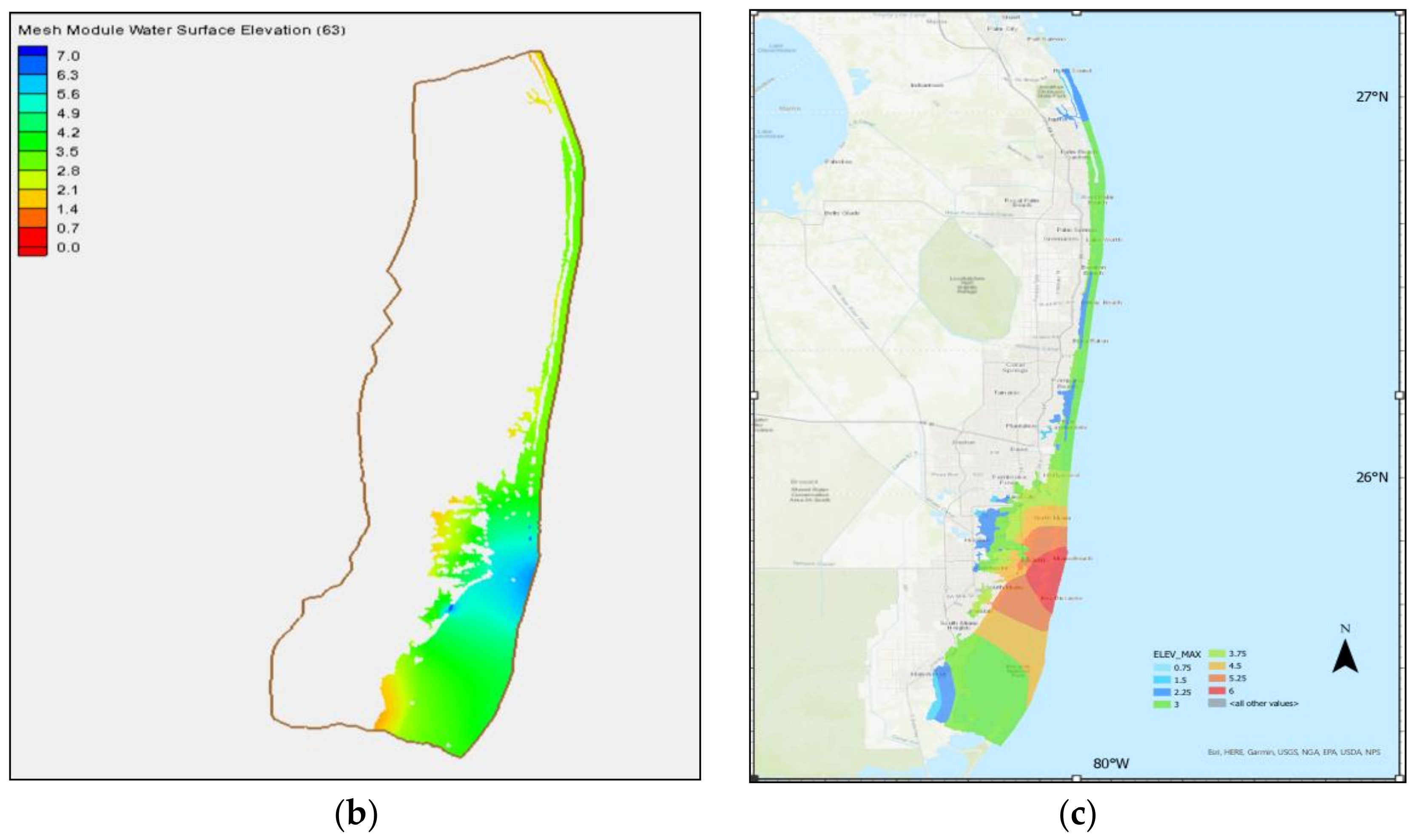
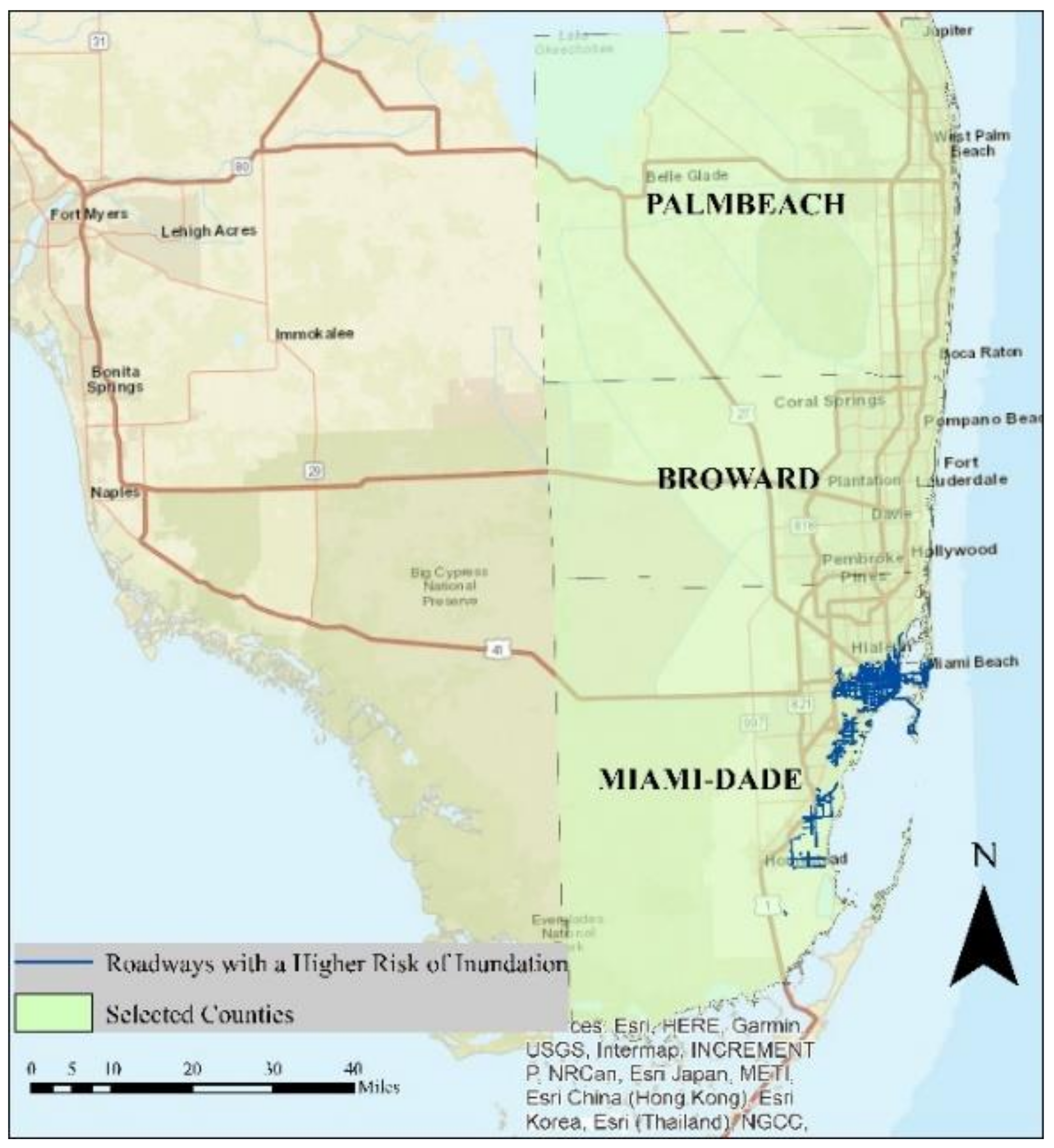

| Data | Type | Source |
|---|---|---|
| Demographics | mdb | SRESP and American Community Survey |
| Shelters | mdb | SFRPC |
| Behavioral Assumptions | mdb | SRESP and SFRPC |
| Hurricane Irma’s Track and Intensity | CSV | NHC |
| Evacuation Zones | mdb | NHC |
| Roadway Network | shp, NET | FDOT Statewide Model Network |
| Regions | Destination Rates |
|---|---|
| Apalachee | 1.85821 |
| Central Florida | 2.44308 |
| East Central Florida | 19.96652 |
| North Central Florida | 2.16183 |
| Northeast Florida | 3.37536 |
| South Florida | 24.96993 |
| Southwest Florida | 3.90035 |
| Tampa Bay | 5.61075 |
| Treasure Coast | 10.97532 |
| Emerald Coast | 3.15146 |
| Others | 21.58720 |
| Broward | Miami-Dade | Palm Beach | Total | |
|---|---|---|---|---|
| Site-Built Population | 636,667 | 1,955,245 | 505,201 | 3,097,113 |
| Mobile Home Population | 51,155 | 37,902 | 46,652 | 135,709 |
| Tourist Population | 37,977 | 93,387 | 11,987 | 143,351 |
| University Population | 0 | 1539 | 355 | 1894 |
| Total Evacuating Population | 725,800 | 2,088,072 | 564,196 | 3,378,068 |
| Sheltering Demand | 33,785 | 98,542 | 35,226 | 167,553 |
| Site-Built Evacuating Vehicles | 275,323 | 682,627 | 246,934 | 1,204,884 |
| Mobile Home Evacuating Vehicles | 22,547 | 16,037 | 19,939 | 58,523 |
| University Evacuating Vehicles | 0 | 1539 | 355 | 1894 |
| Tourist Evacuating Vehicles | 18,989 | 46,693 | 5994 | 71,676 |
| Total Evacuating Vehicles | 316,858 | 746,895 | 273,222 | 1,336,975 |
| County | 61 | 60.5 | 68 | |
| To Shelter | 40 | 60.5 | 28 | |
| Regional Clearance Time: | 68 | |||
Publisher’s Note: MDPI stays neutral with regard to jurisdictional claims in published maps and institutional affiliations. |
© 2021 by the authors. Licensee MDPI, Basel, Switzerland. This article is an open access article distributed under the terms and conditions of the Creative Commons Attribution (CC BY) license (https://creativecommons.org/licenses/by/4.0/).
Share and Cite
Ghorbanzadeh, M.; Vijayan, L.; Yang, J.; Ozguven, E.E.; Huang, W.; Ma, M. Integrating Evacuation and Storm Surge Modeling Considering Potential Hurricane Tracks: The Case of Hurricane Irma in Southeast Florida. ISPRS Int. J. Geo-Inf. 2021, 10, 661. https://doi.org/10.3390/ijgi10100661
Ghorbanzadeh M, Vijayan L, Yang J, Ozguven EE, Huang W, Ma M. Integrating Evacuation and Storm Surge Modeling Considering Potential Hurricane Tracks: The Case of Hurricane Irma in Southeast Florida. ISPRS International Journal of Geo-Information. 2021; 10(10):661. https://doi.org/10.3390/ijgi10100661
Chicago/Turabian StyleGhorbanzadeh, Mahyar, Linoj Vijayan, Jieya Yang, Eren Erman Ozguven, Wenrui Huang, and Mengdi Ma. 2021. "Integrating Evacuation and Storm Surge Modeling Considering Potential Hurricane Tracks: The Case of Hurricane Irma in Southeast Florida" ISPRS International Journal of Geo-Information 10, no. 10: 661. https://doi.org/10.3390/ijgi10100661






